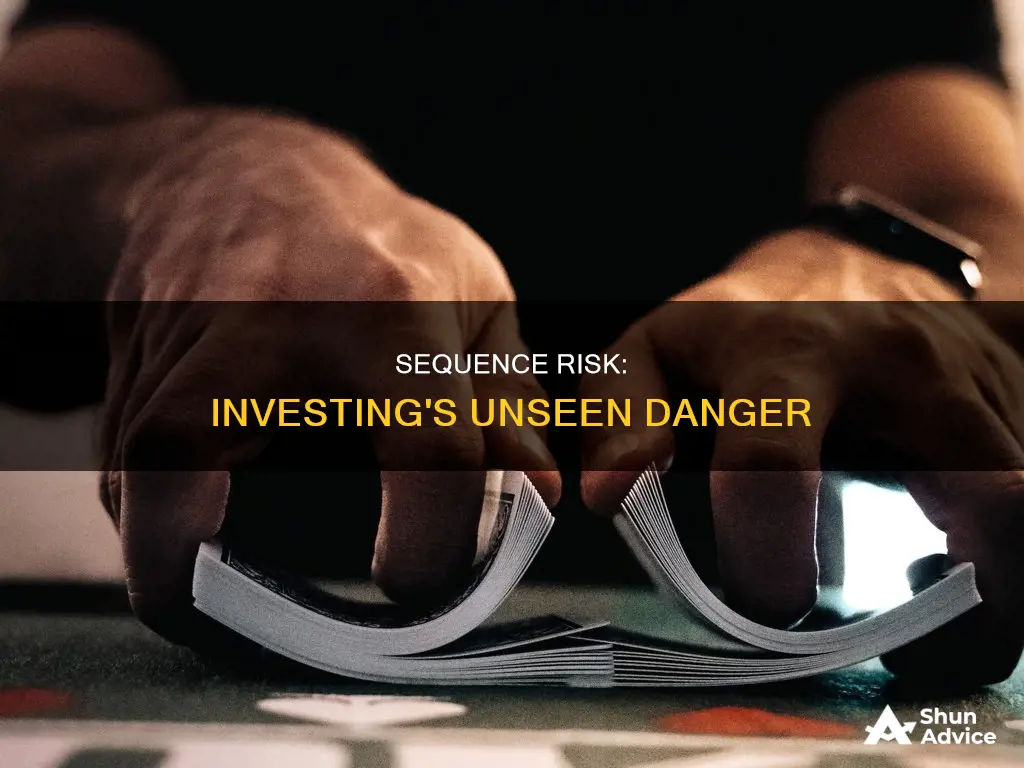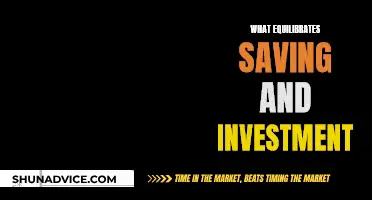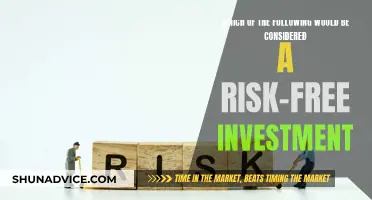
Sequence risk, or sequence-of-returns risk, is a danger to investors that the timing of withdrawals from a retirement account will negatively impact the overall rate of return. In other words, if a portfolio experiences negative returns when withdrawals are happening, it can have a lasting adverse effect on the portfolio's value. Conversely, positive returns in the early stages of retirement can positively influence the longevity of a portfolio. Sequence risk is usually most important during the initial stages of retirement or when withdrawing funds from an investment portfolio.
| Characteristics | Values |
|---|---|
| Definition | Sequence risk, or sequence-of-returns risk, revolves around the timing dynamics in investing. |
| Importance | Sequence risk is most important during the initial stages of retirement or when withdrawing funds from an investment portfolio. |
| Impact | The sequential order of investment returns can have a significant impact on the overall effectiveness of an investment strategy. |
| Negative returns | If a portfolio experiences negative returns when withdrawals are happening, it can have a lasting and adverse effect on the portfolio's value. |
| Positive returns | Positive returns in the early stages of retirement can positively influence the longevity of a portfolio, especially if the early portfolio balance is high. |
| Internal rate of return | Sequence risk can cause investors to earn a much lower internal rate of return than expected. |
| Luck | Sequence risk is, for the most part, a matter of luck. |
| Bull market | If you retire in a bull market, your account may grow large enough to sustain a subsequent downturn. |
| Bear market | If you retire in a bear market, your account balance may never recover. |
What You'll Learn

Sequence risk and retirement
Sequence risk is the danger that the timing of withdrawals from a retirement account will damage the investor's overall return. It is usually most important during the initial stages of retirement or when withdrawing funds from an investment portfolio. The sequential order of investment returns can have a significant impact on the overall effectiveness of an investment strategy.
Sequence risk revolves around the timing dynamics in investing. It is also called sequence-of-returns risk. Timing is everything. If you retire in a bull market, your account may grow large enough to sustain a subsequent downturn. If you retire in a bear market, your account balance may never recover. This is not under the investor's control, but there are opportunities to limit the downside risks.
Sequence risk happens to all investors, but it is more pronounced for retirees who may be more reliant on their portfolio to live off of. It can mean that you earn a much lower internal rate of return than what you expected. For example, if a portfolio experiences negative returns right when withdrawals are happening, especially in retirement, it can have a lasting and adverse effect on the portfolio's value. This is because there are fewer assets left to benefit from potential market recoveries in subsequent periods.
Conversely, positive returns in the early stages of retirement can positively influence the longevity of a portfolio, especially if the early portfolio balance is high. Sequence risk can impact different asset classes in various ways, and investors should be aware that it may be better or worse to treat certain assets in a certain way when they retire.
Indian Stock Market: Best Shares to Invest In
You may want to see also

Sequence risk and the internal rate of return
Sequence risk, or sequence-of-returns risk, revolves around the timing dynamics in investing. It is usually most important during the initial stages of retirement or when withdrawing funds from an investment portfolio. The sequential order of investment returns can have a significant impact on the overall effectiveness of an investment strategy.
Sequence risk is the danger that the timing of withdrawals from a retirement account will damage the investor's overall return. In other words, if a portfolio experiences negative returns when withdrawals are happening, especially in retirement, it can have a lasting and adverse effect on the portfolio's value. This is because there are fewer assets left to benefit from potential market recoveries in subsequent periods. Conversely, positive returns in the early stages of retirement can positively influence the longevity of a portfolio, especially if the early portfolio balance is high.
Sequence risk is, for the most part, a matter of luck. If you retire in a bull market, your account may grow large enough to sustain a subsequent downturn. If you retire in a bear market, your account balance may never recover. This is not under the investor's control, but there are opportunities to limit the downside risks. For example, investors should be aware that it may be better or worse to treat certain assets in a certain way when they retire.
Sequence risk happens to all investors; it's just more pronounced for retirees who may be more reliant on their portfolio to live off of. It can mean that retirees earn a much lower internal rate of return than what they expected.
Investing at 25: Building a Balanced Portfolio for the Future
You may want to see also

Sequence risk and the bull market
Sequence risk, or sequence-of-returns risk, revolves around the timing dynamics of investing. It is usually most important during the initial stages of retirement or when withdrawing funds from an investment portfolio. The sequential order of investment returns can have a significant impact on the overall effectiveness of an investment strategy.
In a bull market, sequence risk can be advantageous. If an investor retires in a bull market, their account may grow large enough to sustain a subsequent downturn. However, the opposite is also true. If an investor retires in a bear market, their account balance may never recover.
The impact of sequence risk is particularly pronounced for retirees who may be more reliant on their portfolio to live off of. Retirees are no longer contributing new capital that could offset losses. As such, sequence risk can have a significant impact on a retiree's overall rate of return.
Sequence risk can also impact different asset classes in various ways. Investors should be aware that it may be better or worse to treat certain assets in a certain way when they retire. While sequence risk is largely a matter of luck, there are opportunities to limit the downside risks.
Can I Deduct Investment Management Service Fees?
You may want to see also

Sequence risk and the bear market
Sequence risk is the danger that the timing of withdrawals from a retirement account will damage the investor's overall return. Sequence risk revolves around the timing dynamics in investing. It is usually most important during the initial stages of retirement or when withdrawing funds from an investment portfolio. The sequential order of investment returns can have a significant impact on the overall effectiveness of an investment strategy.
Sequence risk is also called sequence-of-returns risk. It affects you when you are periodically adding or withdrawing money to or from your investments. In retirement, it can mean that you earn a much lower internal rate of return than what you expected. For example, if you retire in a bull market, your account may grow large enough to sustain a subsequent downturn. However, if you retire in a bear market, your account balance may never recover. This is not under the investor's control, but there are opportunities to limit the downside risks.
Note that sequence risk happens to all investors; it's just more pronounced for retirees who may be more reliant on their portfolio to live off of. Sequence risk can impact different asset classes in various ways, and investors should be aware that it may be better or worse to treat certain assets in a certain way when they retire.
Encouraging Corporations to Invest in Green Energy
You may want to see also

Sequence risk and asset classes
Sequence risk, or sequence-of-returns risk, revolves around the timing dynamics of investing. It is usually most important during the initial stages of retirement or when withdrawing funds from an investment portfolio. The sequential order of investment returns can have a significant impact on the overall effectiveness of an investment strategy. For example, if a portfolio experiences negative returns when withdrawals are happening, especially in retirement, it can have a lasting and adverse effect on the portfolio's value. This is because there are fewer assets left to benefit from potential market recoveries in subsequent periods.
Conversely, positive returns in the early stages of retirement can positively influence the longevity of a portfolio, especially if the early portfolio balance is high. Sequence risk happens to all investors, but it is more pronounced for retirees who may be more reliant on their portfolio to live off. It can impact different asset classes in various ways, and investors should be aware that it may be better or worse to treat certain assets in a certain way when they retire.
For example, if an investor retires in a bull market, their account may grow large enough to sustain a subsequent downturn. Conversely, if they retire in a bear market, their account balance may never recover. This is not under the investor's control, but there are opportunities to limit the downside risks. Sequence risk can be mitigated by periodically adding or withdrawing money from investments.
Equities in the 80s: A Decade of Investment Opportunities
You may want to see also
Frequently asked questions
Sequence risk is the danger that the timing of withdrawals from a retirement account will damage the investor's overall return.
Sequence risk revolves around the timing dynamics in investing. It's usually most important during the initial stages of retirement or when withdrawing funds from an investment portfolio.
Sequence risk can mean that you earn a much lower internal rate of return than what you expected. If you retire in a bear market, your account balance may never recover.
Sequence risk happens to all investors, but there are opportunities to limit the downside risks. Investors should be aware that it may be better or worse to treat certain assets in a certain way when they retire.
The sequential order of investment returns can have a significant impact on the overall effectiveness of an investment strategy. If a portfolio experiences negative returns when withdrawals are happening, there are fewer assets left to benefit from potential market recoveries in subsequent periods.







